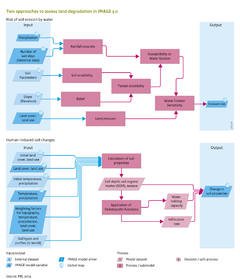Land degradation/Description: Difference between revisions
Jump to navigation
Jump to search
No edit summary |
No edit summary |
||
| Line 66: | Line 66: | ||
* soil texture (sand and clay content). | * soil texture (sand and clay content). | ||
S-World is based on the global Harmonised World Soil Database ([[HWSD database|HWSD]]; ([[FAO et al., 2009]]) and the [[WISE database|WISE soil profile database]] ([[Batjes, 2009]]). The compound mapping units in HWSD were disaggregated using detailed terrain information, so that each grid cell could be linked to a unique soil type described in the WISE database. For each soil type, ranges for the main soil characteristics described above were assessed on the basis of the WISE soil profiles. The range of variable, i.e., soil property v for every soil type s is subsequently defined as [v<sub>ls</sub>..v<sub>hs</sub>] in which v<sub>ls</sub> corresponds to the 1<sup>st</sup> decile and v<sub>hs</sub> to the 9<sup>th</sup> decile. S-World downscales each soil property v based on 5 landscape properties or explanatory factors [''p<sub>1</sub>,p<sub>2</sub>… p<sub>5</sub>'']. These explanatory factors are | S-World is based on the global Harmonised World Soil Database ([[HWSD database|HWSD]]; ([[FAO et al., 2009]]) and the [[WISE database|WISE soil profile database]] ([[Batjes, 2009]]). The compound mapping units in HWSD were disaggregated using detailed terrain information, so that each grid cell could be linked to a unique soil type described in the WISE database. For each soil type, ranges for the main soil characteristics described above were assessed on the basis of the WISE soil profiles. The range of variable, i.e., soil property v for every soil type s is subsequently defined as [v<sub>ls</sub>..v<sub>hs</sub>] in which v<sub>ls</sub> corresponds to the 1<sup>st</sup> decile and v<sub>hs</sub> to the 9<sup>th</sup> decile. S-World downscales each soil property v based on 5 landscape properties or explanatory factors [''p<sub>1</sub>,p<sub>2</sub>… p<sub>5</sub>'']. These explanatory factors are: temperature, precipitation, slope, land management, and land cover. The land management is set to: | ||
: temperature, | |||
The land management is set to | |||
* 1.0 for cropland, | * 1.0 for cropland, | ||
* 0.5 for mosaics of cropland and pasture or natural vegetation, | * 0.5 for mosaics of cropland and pasture or natural vegetation, | ||
* 0.3 for pasture, and | * 0.3 for pasture, and | ||
* 0.0 for natural vegetation | * 0.0 for natural vegetation; | ||
Land cover is characterised by a remotely sensed {{abbrTemplate|NDVI}} map. The soil property v at location x with soil s is estimated as {{DisplayFigureLeftOptimalTemplate|Formula1 LD|plain}} | Land cover is characterised by a remotely sensed {{abbrTemplate|NDVI}} map. | ||
The soil property v at location x with soil s is estimated as {{DisplayFigureLeftOptimalTemplate|Formula1 LD|plain}} | |||
with w<sub>x </sub>being a weight w∈ [0..1] that determines where v is in the range [v<sub>ls</sub>..v<sub>hs</sub> ]. Different explanatory factors represented by the landscape properties determine w. The weight at location x is calculated as {{DisplayFigureLeftOptimalTemplate|Formula4 LD|plain}} | with w<sub>x </sub>being a weight w∈ [0..1] that determines where v is in the range [v<sub>ls</sub>..v<sub>hs</sub> ]. Different explanatory factors represented by the landscape properties determine w. The weight at location x is calculated as {{DisplayFigureLeftOptimalTemplate|Formula4 LD|plain}} | ||
The weight w<sub>px</sub> for landscape property p is calculated as: {{DisplayFigureLeftOptimalTemplate|Formula2 LD|plain}} | The weight w<sub>px</sub> for landscape property p is calculated as: {{DisplayFigureLeftOptimalTemplate|Formula2 LD|plain}} | ||
Revision as of 12:18, 19 May 2014
Parts of Land degradation/Description
| Component is implemented in: |
|
| Related IMAGE components |
| Projects/Applications |
| Models/Databases |
| Key publications |
| References |
